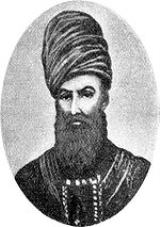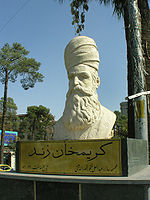
Karim Khan
Encyclopedia
Karim Khan Zand, (c. 1705- 1779), was a ruler of Iran
, and the founder of the Zand Dynasty
.
He was born to a family of the Zand tribe
of Lur
or Lak
deportees. Kurdish nationalists
such as Abdul Rahman Ghassemlou
considered him as a Kurdish hero Modern scholarships such as Wadie Jwaideh suggested his proud Kurdishness.
He never styled himself as "shah" or king, and instead used the title Vakil e-Ra'aayaa (Representative of the People).
Karim Khan Zand was one of the generals of Nader Shah Afshar. After Nader Shah's death in 1747, Persia fell into a state of civil war. At that time, Karim Khan, Abolfath Khan and Ali Mardan Khan reached an agreement to divide the country among themselves and give the throne to Ismail III. However, the cooperation ended after Ali Mardan Khan invaded Isfahan
and killed Abdolfath Khan. Subsequently, Karim Khan killed Ali Mardan Khan and gained control over all of Iran except Khorasan
, ruled by Shahrokh
, grandson of Nader Shah. Nevertheless, he did not adopt the title of Shah for himself, preferring the title, Vakil e-Ra'aayaa (Advocate of the People = People's President)
While Karim was ruler, Persia recovered from the devastation of 40 years of war, providing the war ravaged country with a renewed sense of tranquility, security, peace, and prosperity.
During his reign,relations with Britain
were restored, and he allowed the East India Company
to have a trading post in southern Iran. He made Shiraz
his capital and ordered the construction of several architectural projects there. Following Karim Khan's death, civil war broke out once more, and none of his descendants were able to rule the country as effectively as he had. The last of these descendants, Lotf Ali Khan
, was killed by Agha Mohammad Khan, and the Qajar dynasty
came to power.
 To this day, he has a reputation as one of the most just and able rulers in Iranian history. A wealth of tales and anecdotes portray Karim Khan as a compassionate ruler, genuinely concerned with the welfare of his subjects. In the words of John Malcolm, "The happy reign of this excellent prince, as contrasted with those who preceded and followed him, affords the historian of Persia that kind of mixed pleasure and repose, which a traveler enjoys on arriving in a beautiful and fertile valley during an arduous journey over barren and rugged wastes. It is pleasing to recount the actions of a chief who, though born of an inferior rank, obtained power without crime, and who exercised it with a moderation that, for the times in which he lived, was as singular as his humanity and justice." (John Malcolm, The History of Persia, 1829)
To this day, he has a reputation as one of the most just and able rulers in Iranian history. A wealth of tales and anecdotes portray Karim Khan as a compassionate ruler, genuinely concerned with the welfare of his subjects. In the words of John Malcolm, "The happy reign of this excellent prince, as contrasted with those who preceded and followed him, affords the historian of Persia that kind of mixed pleasure and repose, which a traveler enjoys on arriving in a beautiful and fertile valley during an arduous journey over barren and rugged wastes. It is pleasing to recount the actions of a chief who, though born of an inferior rank, obtained power without crime, and who exercised it with a moderation that, for the times in which he lived, was as singular as his humanity and justice." (John Malcolm, The History of Persia, 1829)
He is buried at Pars Museum of Shiraz
.
Iran
Iran , officially the Islamic Republic of Iran , is a country in Southern and Western Asia. The name "Iran" has been in use natively since the Sassanian era and came into use internationally in 1935, before which the country was known to the Western world as Persia...
, and the founder of the Zand Dynasty
Zand dynasty
The Zand dynasty ruled southern and central Iran in the 18th century.- Karim Khan Zand :The dynasty was founded by Karim Khan, chief of the Zand tribe which was Lur or Lak deportees. Modern scholarships such as Wadie Jwaideh suggested his Kurdishness. He became one of Nader Shah's generals...
.
He was born to a family of the Zand tribe
Zand tribe
The Zand tribe are a tribe of Fayli of Lorestan, most known for their member, Muhammad Karim Khan Zand, who become the Regent of Southern Persia for Ismail III in 1750. After Zand's death in 1779, internal conflicts for his succession resulted in a weakening of the dynasty, ending with the defeat...
of Lur
Lurs
Lurs are an Iranic people living mainly in south-western Iran. Their population is estimated at above two million. They occupy Lorestan, Bakhtiari, and Kuh-Gilu-Boir Ahmed. "....
or Lak
Lak people (Iran)
The Laks are an Iranian group in southwestern Iran. They speak Laki , a Northwestern Iranian language, that is usually grouped with Southern Kurdish dialects...
deportees. Kurdish nationalists
Kurdish nationalism
Kurdish nationalism is the political movement that holds that the Kurdish people are a nation deserving of a sovereign homeland, Kurdistan out of the territories where Kurdish people form a majority...
such as Abdul Rahman Ghassemlou
Abdul Rahman Ghassemlou
Abdul Rahman Ghassemlou was a Kurdish political leader.Ghassemlou was the leader of the Kurdistan Democratic Party of Iran from 1973 to 1989, when he was assassinated by perpetrators thought to be agents of the Islamic...
considered him as a Kurdish hero Modern scholarships such as Wadie Jwaideh suggested his proud Kurdishness.
He never styled himself as "shah" or king, and instead used the title Vakil e-Ra'aayaa (Representative of the People).
Karim Khan Zand was one of the generals of Nader Shah Afshar. After Nader Shah's death in 1747, Persia fell into a state of civil war. At that time, Karim Khan, Abolfath Khan and Ali Mardan Khan reached an agreement to divide the country among themselves and give the throne to Ismail III. However, the cooperation ended after Ali Mardan Khan invaded Isfahan
Isfahan (city)
Isfahan , historically also rendered in English as Ispahan, Sepahan or Hispahan, is the capital of Isfahan Province in Iran, located about 340 km south of Tehran. It has a population of 1,583,609, Iran's third largest city after Tehran and Mashhad...
and killed Abdolfath Khan. Subsequently, Karim Khan killed Ali Mardan Khan and gained control over all of Iran except Khorasan
Greater Khorasan
Greater Khorasan or Ancient Khorasan is a historical region of Greater Iran mentioned in sources from Sassanid and Islamic eras which "frequently" had a denotation wider than current three provinces of Khorasan in Iran...
, ruled by Shahrokh
Shah Rukh of Persia
Shahrukh Shah Afshar, also spelled Shahrokh was a king of the Afsharid dynasty and a contemporary of the Zand kings. He reigned until 1796....
, grandson of Nader Shah. Nevertheless, he did not adopt the title of Shah for himself, preferring the title, Vakil e-Ra'aayaa (Advocate of the People = People's President)
While Karim was ruler, Persia recovered from the devastation of 40 years of war, providing the war ravaged country with a renewed sense of tranquility, security, peace, and prosperity.
During his reign,relations with Britain
United Kingdom
The United Kingdom of Great Britain and Northern IrelandIn the United Kingdom and Dependencies, other languages have been officially recognised as legitimate autochthonous languages under the European Charter for Regional or Minority Languages...
were restored, and he allowed the East India Company
British East India Company
The East India Company was an early English joint-stock company that was formed initially for pursuing trade with the East Indies, but that ended up trading mainly with the Indian subcontinent and China...
to have a trading post in southern Iran. He made Shiraz
Shiraz, Iran
Shiraz is the sixth most populous city in Iran and is the capital of Fars Province, the city's 2009 population was 1,455,073. Shiraz is located in the southwest of Iran on the Roodkhaneye Khoshk seasonal river...
his capital and ordered the construction of several architectural projects there. Following Karim Khan's death, civil war broke out once more, and none of his descendants were able to rule the country as effectively as he had. The last of these descendants, Lotf Ali Khan
Lotf Ali Khan
Lutf or Lotf Ali Khan was the last Shah of Persia of the Zand dynasty.Lotf Ali Khan Zand came to power after a decade of infighting among a succession of violent and inept Zand chiefs following the death in 1779 of the dynasty's founder, Karim Khan Zand...
, was killed by Agha Mohammad Khan, and the Qajar dynasty
Qajar dynasty
The Qajar dynasty was an Iranian royal family of Turkic descent who ruled Persia from 1785 to 1925....
came to power.

He is buried at Pars Museum of Shiraz
Pars Museum of Shiraz
The Pars Museum is a museum in Shiraz, Fars Province, southern Iran.The octagonal building was where royal guests were hosted during the Zand dynasty of Iran.It is also the burial place of is also where Karim Khan Zand....
.
External links
See also
- History of IranHistory of IranThe history of Iran has been intertwined with the history of a larger historical region, comprising the area from the Danube River in the west to the Indus River and Jaxartes in the east and from the Caucasus, Caspian Sea, and Aral Sea in the north to the Persian Gulf and the Gulf of Oman and Egypt...
- History of Kurdistan
- List of kings of Persia
- list of Kurdish people
- Zand dynastyZand dynastyThe Zand dynasty ruled southern and central Iran in the 18th century.- Karim Khan Zand :The dynasty was founded by Karim Khan, chief of the Zand tribe which was Lur or Lak deportees. Modern scholarships such as Wadie Jwaideh suggested his Kurdishness. He became one of Nader Shah's generals...
- Hyder AliHyder AliHyder Ali was the de facto ruler of the Kingdom of Mysore in southern India. Born Hyder Naik, he distinguished himself militarily, eventually drawing the attention of Mysore's rulers...

